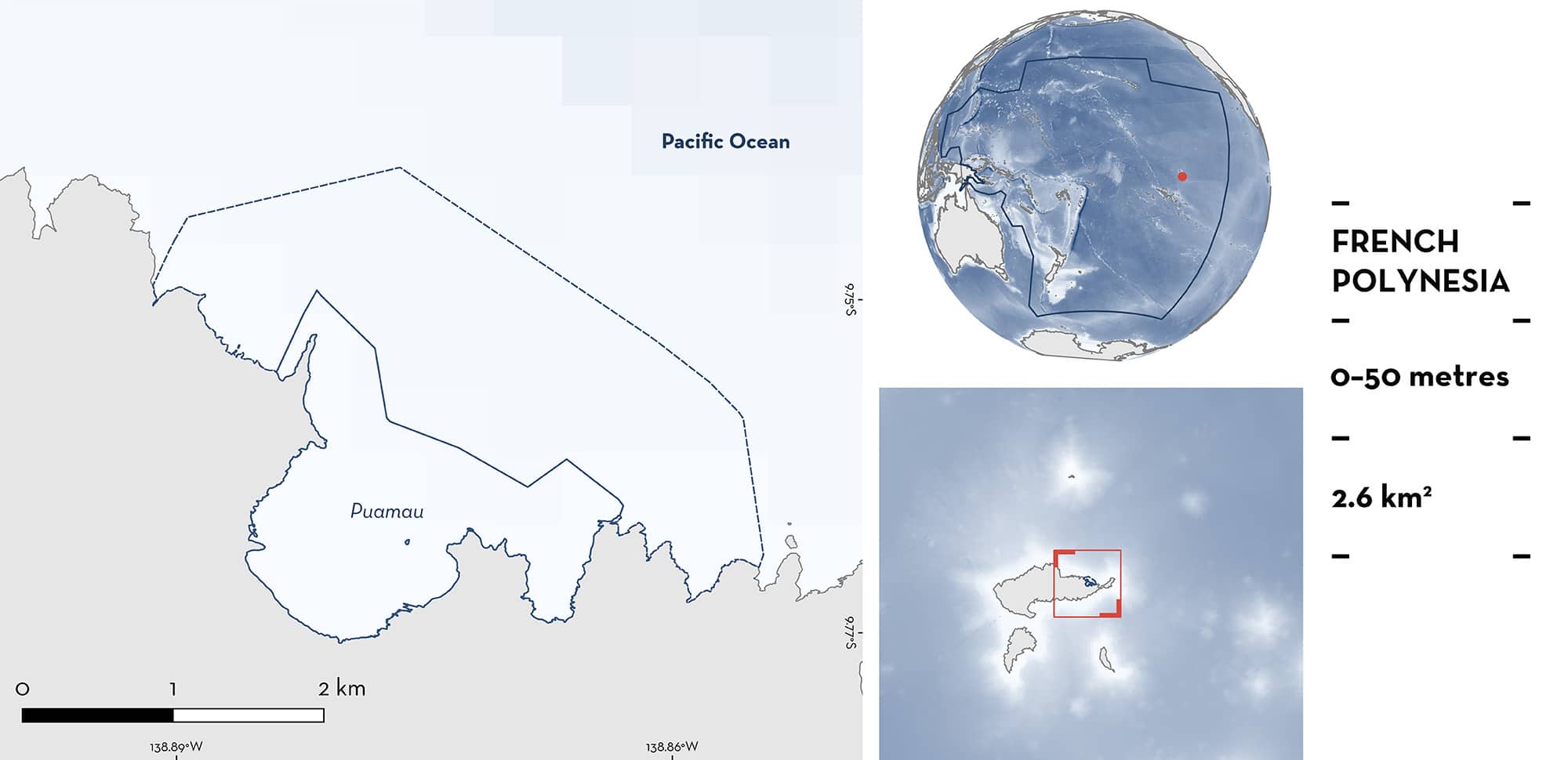ISRA FACTSHEETS
ISRA FACTSHEETS
NEW ZEALAND & PACIFIC ISLANDS REGION
Puamau
Summary
Puamau is located on the north coast of Hiva Oa Island in the Marquesas Archipelago in French Polynesia. This area encompasses the bay of Puamau and a small islet within the bay. It is characterised by small areas of hard coral. The area experiences high primary productivity due to the underwater topography and the strong currents. This area overlaps with the Motane (Mohotani) Marine Key Biodiversity Area. Within this area there are: threatened species and feeding areas (Reef Manta Ray Mobula alfredi).
Download factsheet
Puamau
DESCRIPTION OF HABITAT
Puamau is located on the north coast of Hiva Oa Island in the Marquesas Archipelago in French Polynesia. The area encompasses the bay of Puamau and a small islet within the bay. Puamau is characterised by high concentrations of zooplankton and small areas of hard coral, especially around the islet (M Santangelo pers. obs. 2019). The area is affected by a moderately defined thermocline and a significant decrease in oxygen levels at depths of 250–300 m (Agence des Aires Marines Protégées 2016). Puamau also experiences high primary productivity that is attributed to the interaction between the complex underwater topography of these islands and the strong currents that continuously flow around the archipelago, especially between October–April when the South Equatorial Current and related water circulation patterns enhance nutrient availability (Martinez & Maamaatuaiahutapu 2004; Agence des Aires Marines Protégées 2016).
The area overlaps with the Motane (Mohotani) Marine Key Biodiversity Area (KBA 2024).
This Important Shark and Ray Area is benthopelagic and is delineated from inshore and surface waters (0 m) to 50 m based on the bathymetry of the area.
CRITERION A
VULNERABILITY
One Qualifying Species considered threatened with extinction according to the IUCN Red List of Threatened Species regularly occurs in the area. This is the Vulnerable Reef Manta Ray (Marshall et al. 2022).
CRITERION C
SUB-CRITERION C2 – FEEDING AREAS
Puamau is an important feeding area for one ray species.
Large groups of Reef Manta Rays aggregate in this area to feed on the productive waters at the bay of Puamau. Between 2018–2023, three scientific expeditions recorded feeding aggregations (n = 7) within the area while snorkelling or diving in 2018 (August, n = 1), 2019 (May, n = 3), and 2023 (May, n = 3) (M Santangelo pers. obs. 2023; French Polynesia Manta Project unpubl. data 2024). A total of 14 individuals were photo-identified in the area (13% of Hiva Oa population, n = 104), with only one individual resighted on the south coast of the Hiva Oa Island. Feeding aggregations comprised between 8–20 individuals feeding for extended periods of time (3–4 hours) (M Santangelo pers. obs. 2024).
Local ecological knowledge from interviews among the local population in the island also confirm the historic importance of this area for manta rays, with regular observations year-round (although identification at species level was not provided) (Agence des Aires Marines Protégées 2016; A Carpentier pers. obs. 2024).
Feeding aggregations in this area are likely tied to the enhanced productivity the Marquesas Archipelago experiences, driven by the Island Mass Effect and the island’s unique bathymetry, with peak productivity occurring between October–April (Martinez & Maamaatuaiahutapu 2004; French Polynesia Manta Project unpubl. data 2024). Surveys being conducted outside of the peak season, indicate that feeding aggregations are still occurring, emphasising the critical importance of this region for Reef Manta Rays even during lower productivity periods.
Download factsheet
SUBMIT A REQUEST
ISRA SPATIAL LAYER REQUEST
To make a request to download the ISRA Layer in either a GIS compatible Shapefile (.shp) or Google Earth compatible Keyhole Markup Language Zipped file (.kmz) please complete the following form. We will review your request and send the download details to you. We will endeavor to send you the requested files as soon as we can. However, please note that this is not an automated process, and before requests are responded to, they undergo internal review and authorization. As such, requests normally take 5–10 working days to process.
Should you have questions about the data or process, please do not hesitate to contact us.


